Q:What is the Super Famicom?
A: Known as the Super Nintendo (SNES) outside of Japan, the Super Famicom is Nintendo's 16-bit console that was released in the early 90s. Same console, just different names. They are cosmetically different, but as far as I know they are internally the same. "Famicom," short for "Family Computer," was the name of the original 8-bit Nintendo Entertainment System from the 80's, and it's popularity in Japan has led to the term "famicom" as meaning console-based video games in general (called "TV Game" or "terebi geemu in Japan). This is why many video game shops in Japan are called "Famicom shops." At the time the Super Famicom was released in Japan, it's main console rivals were the NEC PC Engine (Turbographix 16) and the Sega Megadrive (Genesis).
Q: Do I need an adaptor?
A: Not really. Buying an adaptor off the Net or mail order can cost you up to $30. But there's a way around that. Basically, the only main difference between SFC and SNES cartridges (besides basic design) is that SNES cartridges have two slots on the back where they fit inside your console. Open the flap of your console and look inside. Notice those tabs? These tabs are what the slots fit around when the cartridge is inserted. These crummy little tabs are the only thing stopping you from playing your SFC game. The plastic tabs serve no real functioning purpose other than to prevent you from inserting the SFC cartridge. With a pair of pliers, you can bust these tabs out with a bit of strength. Somebody told me that he used gardening shears to cut them out. Whatever works, I guess. The only thing you need to be careful about is getting crazy and accidentally damaging the actual cartridge slot. I had no real problem with this operation. However, It is entirely your decision if you wish to use an adaptor. If you want to avoid voiding your warranty, you may want to buy an adaptor. All that these do is just extend the cartridge slot. Another good thing about an adaptor is that you can take it with you when you bring your SFC game(s) to your friend's house to play it on his/her SNES. This way you won't have to bust his/her tabs out or bring your own modified SNES along with you. (I have to bring my modified SNES over to my friends' houses to play my SFC games there. Fortunately this doesn't happen too often.)
Another thing: I have heard from people who have used a soldering iron to melt grooves into their Super Famicom games. Don't do this! It's much better just to bust out the tabs from your console. The only practical reason for melting grooves into cartridges is if you are running a video game rental store (I saw one store that did this).
However, if you must have a converter, I suggest that you try buying one on either eBay or elsewhere on the Web.
Q: Where can I get Super Famicom import games?
A: The Internet is probably your best bet on finding SFC games, aside from going to Japan yourself and buying them there. As much as I hate to say it, eBay may be your best bet to find Super Famicom import games. There are several reputable sellers on eBay that sell retro games for Super Famicom, PC Engine, Megadrive, and other classic consoles, and they are in good condition too. My favorite by far has to be Hit Japan, located in Sapporo, Japan.
National Console Support is a great import shop where you can still buy SFC imports. They have a moderately sized, yet interesting selection. Also take a look at my Links page for some other places to buy SFC games. Even amazon.com has import SFC games for sale.
Please, don't e-mail me with requests for specific games. The Anime Super Famicom Web Resource Center is not a business that sells games, nor is it a service that finds imports for you. And I'm not the kind of guy who sells or trades his own games. When I buy a game, it's mine to keep. If you want to know where I've bought my games, most of my import games I have bought in Japan.
Q: What about the Japanese instructions? I can't read Japanese!
A: This is something you must always be careful about when deciding on buying a Japanese import game. The reviews on the Anime Super Famicom page will indicate whether the game requires Japanese reading ability in order to play it. Your best source of English translations/walkthroughs for popular Super Famicom games is GameFaqs.com. More than likely, you can find what you're looking for there. You can also search for gameplay videos on Youtube and see for yourself.
Knowing how to read Katakana can be a big help. Katakana is the Japanese style of writing primarily reserved for words that are foreign to the Japanese language. Katakana is fairly recognizable in that it is basically scripted in (more or less) straight lines. I have been able to understand the basics of game play this way. When I first got my first import SFC game, Ranma 1/2: Super Battle, I was able to understand all of the moves by knowing how to read "kiku" (kick) and "panchi" (punch). I learned how to use the super moves by reading the FAQ. But once again, ask if you need help if you can't read Japanese. And when it comes to on-screen text, don't buy a game that requires Japanese reading ability if you don't know Japanese unless you are very patient and want to spend hours at a time using the trial and error method. Some games, such as Macross: Scrambled Valkyrie, have all of their on-screen text in English.
Q: Where can I download SNES ROMS?
 A: There are legal issues that arise with having SNES emulator ROM games on your computer, so I will not make them available on this page. So please don't ask me for them! And DON'T ask me where you can download them from other sites. These ROM sites are gone as soon as they're put up, so it's useless to link to them. And don't ask me to find them for you, either. You know what an Internet search engine is, so use your brain! Sorry about ranting like that. You wouldn't believe how many e-mail I've received from stupid people about ROMs.
A: There are legal issues that arise with having SNES emulator ROM games on your computer, so I will not make them available on this page. So please don't ask me for them! And DON'T ask me where you can download them from other sites. These ROM sites are gone as soon as they're put up, so it's useless to link to them. And don't ask me to find them for you, either. You know what an Internet search engine is, so use your brain! Sorry about ranting like that. You wouldn't believe how many e-mail I've received from stupid people about ROMs.
For those of you who don't know what ROMs are, they are games you can download onto your computer and play with an emulator like ZSNES or SNES9X. Basically, emulators allow you to (somewhat) play SNES/SFC games on your computer. But I stress that no matter what country you live in, it is illegal to have a ROM of a game that you have not paid for. These emulated games are kinda nice, but they are in no way a true substitute for the real cartridge game. Emulation can still tend to be glitchy with video and sound being messed up, and they are not as satisfying to play as the real thing. I use them for screen captures of the games I review on this page.
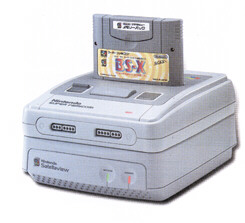 Q:Was there ever a use for the expansion port under the console?
Q:Was there ever a use for the expansion port under the console?
A: Yes, there was a use for this mysterious expansion port, at least in Japan. There is a peripheral called the Satellaview that plugged into this expansion port, and the Super famicom rode piggyback on top of it. This device allowed players to download games through satellite signals at certain times of the day and save them to small Game Boy-style cartridges. Apparently there was an exclusive 16-bit version of the original Zelda game that could be played on the Super Famicom! You can find good sources of information on the Satellaview by doing a search on Google.
The proposed Super Famicom CD-ROM system was also supposed to utilize this expansion port.
Q: What is this Super Famicom Disk System I've heard about?
A: A Super Famicom Disk System is an augmentation that fits onto your SNES/SFC console, just like a Sega Genesis CD or 32X or an Atari Jaguar CD does. But instead of a CD drive, it's a disk drive. It uses 3.5" disks, and it plugs into the cartridge slot. I'm not sure, but there might be others that connect to the expansion port on the bottom of the SNES. All I know is that it is a facility that allows you to copy your SFC/SNES games onto disk, and it allows you to run the games from these disks. And of course, you can run downloaded ROMS on the disk system from the floppy disks or downloaded from your computer through a parallel port connector (if the disk system supports that). The disk system that set the standard for ROMs was the Super Magicom, but the most popular disk system for the SNES/SFC is the Super Wildcard DX. The main reason why there is a Super Famicom Disk System is for the backup of games, but of course it results in piracy. Unlike the 8-bit Famicom Disk System that was made by Nintendo (a peripheral never released outside of Japan), the Super Famicom Disk System is made by unofficial, unlicensed companies. There were games that were exclusive to the Famicom Disk System, such as Metroid, Legend of Zelda and Dirty Pair. There used to be vending machines in Japan that would copy such games onto disk for customers. I think Nintendo never released an official Super Famicom Disk System due to the piracy issue that arose with the first disk system. I have no idea where to get a Super Famicom Disk System, so please don't ask me. For more information on various disk systems, check out this site.
Thanks to Luis Cruz and David Snyder for giving me some information on this topic and correcting me on a few points.
Q: What are Super Famicom Memory Cassettes?
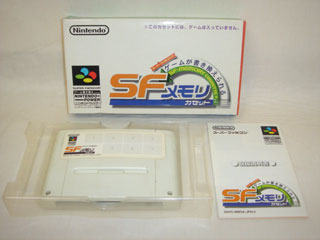 These are not bootleg cartridges from Korea or Taiwan. The Super Famicom Data Cartridge was an officially licensed product in Japan. Between 1996 and 1998 in Japan, consumers could purchase these blank cartridges from vendors at a reduced rate and then either go to certain retailers or mail the cartridge to Nintendo through a service called "Nintendo Power" (which had absolutely nothing to do with the American magazine). The Nintendo Power service offered about twenty different games to choose from. Among those were a dozen or so that had previously shown up as broadcast Stelleview games. The Nintendo Power service was the only way of getting cartridge versions of these games. Some of these games included Super Picross, Super Wrecking Crew, Super Famicom Wars, and a remake of Famicom Detective Club Part II.
These are not bootleg cartridges from Korea or Taiwan. The Super Famicom Data Cartridge was an officially licensed product in Japan. Between 1996 and 1998 in Japan, consumers could purchase these blank cartridges from vendors at a reduced rate and then either go to certain retailers or mail the cartridge to Nintendo through a service called "Nintendo Power" (which had absolutely nothing to do with the American magazine). The Nintendo Power service offered about twenty different games to choose from. Among those were a dozen or so that had previously shown up as broadcast Stelleview games. The Nintendo Power service was the only way of getting cartridge versions of these games. Some of these games included Super Picross, Super Wrecking Crew, Super Famicom Wars, and a remake of Famicom Detective Club Part II.
Super Famicom Data Cartridges were an update to the aging Famicom Disk System write kiosks where players could take their FDS games and rewrite them with new games. The only difference was instead of writing to a diskette, flash RAM was the new storage medium. The Super Famicom Data Cartridge had a storage capacity of 32 megs, allowing eight 4-meg games, two 16-meg games or one 32-meg game.
Nintendo discontinued the Nintendo Power service in 1999, making blank Super Famicom Data cartridges essentially worthless today. However, due to the fact that many of the games released via Nintendo Power are exclusive to the data cartridges, data cartridges with specific desired titles are very rare even in Japan and fetch quite a bit.
This information about the SF Memory Cassettes was provided by a guy called Satoshi Matrix on the Racketboy Forum. Check out his blog, the Retro And Contemporary Gaming Archives.
Image courtesy of Hit Japan.
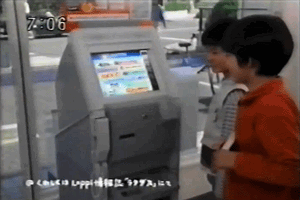
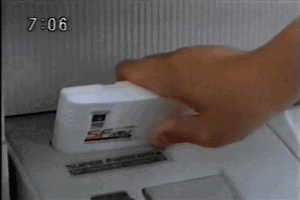
Here are scenes from a commercial for Fire Emblem Tracia 776, featuring children purchasing the game at a Lawson Station convenience store and downloading it onto a Memory Cassette for play at home. Images taken from the commercial on YouTube.
Q: I'd like to contribute a review for the Anime SFC Web Resource Center. How do I go about doing this?
A: If you would like to contribute a review, by all means let me know. Several people have done this so far. Look at the rating guide for the suggested way to rate the game in different categories. You don't really need to include all the categories, nor do you necessarily have to follow this rating system, since it is just a suggestion. The review itself doesn't need to be totally in-depth, it could only be a few sentences for each category. For an objective review you only need to tell a little about the game itself, what you liked about the game and what you didn't like, and your overall impression. No big deal; pretty painless. Or if you wish, you can just make a short summary of the game to be included on the Snapshots page. You can make a text file of it and attach it to me in an e-mail, or just include your review in the body of the e-mail itself.
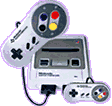

 Back to the Anime Super Famicom Main Page
Back to the Anime Super Famicom Main Page
 A: There are legal issues that arise with having SNES emulator ROM games on your computer, so I will not make them available on this page. So please don't ask me for them! And DON'T ask me where you can download them from other sites. These ROM sites are gone as soon as they're put up, so it's useless to link to them. And don't ask me to find them for you, either. You know what an Internet search engine is, so use your brain! Sorry about ranting like that. You wouldn't believe how many e-mail I've received from stupid people about ROMs.
A: There are legal issues that arise with having SNES emulator ROM games on your computer, so I will not make them available on this page. So please don't ask me for them! And DON'T ask me where you can download them from other sites. These ROM sites are gone as soon as they're put up, so it's useless to link to them. And don't ask me to find them for you, either. You know what an Internet search engine is, so use your brain! Sorry about ranting like that. You wouldn't believe how many e-mail I've received from stupid people about ROMs.  Q:Was there ever a use for the expansion port under the console?
Q:Was there ever a use for the expansion port under the console? 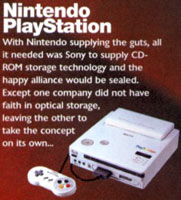




 Back to the Anime Super Famicom Main Page
Back to the Anime Super Famicom Main Page